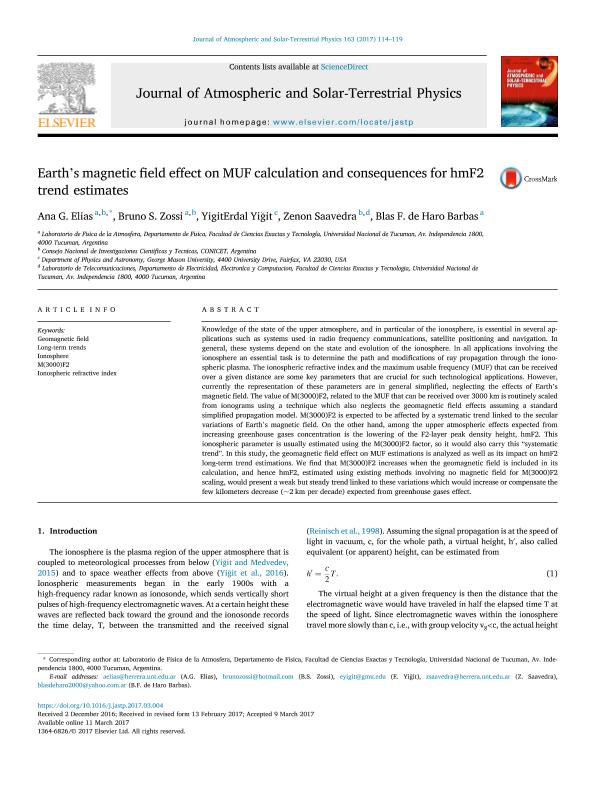Mostrar el registro sencillo del ítem
dc.contributor.author
Elias, Ana Georgina

dc.contributor.author
Zossi, Bruno Santiago

dc.contributor.author
Yigit, Erdal
dc.contributor.author
Saavedra, Zenon

dc.contributor.author
de Haro Barbás, Blas Federico

dc.date.available
2018-08-15T19:30:59Z
dc.date.issued
2017-10
dc.identifier.citation
Elias, Ana Georgina; Zossi, Bruno Santiago; Yigit, Erdal; Saavedra, Zenon; de Haro Barbás, Blas Federico; Earth's magnetic field effect on MUF calculation and consequences for hmF2 trend estimates; Elsevier; Journal of Atmospheric and Solar-Terrestrial Physics; 163; 10-2017; 114-119
dc.identifier.issn
1364-6826
dc.identifier.uri
http://hdl.handle.net/11336/55720
dc.description.abstract
Knowledge of the state of the upper atmosphere, and in particular of the ionosphere, is essential in several applications such as systems used in radio frequency communications, satellite positioning and navigation. In general, these systems depend on the state and evolution of the ionosphere. In all applications involving the ionosphere an essential task is to determine the path and modifications of ray propagation through the ionospheric plasma. The ionospheric refractive index and the maximum usable frequency (MUF) that can be received over a given distance are some key parameters that are crucial for such technological applications. However, currently the representation of these parameters are in general simplified, neglecting the effects of Earth's magnetic field. The value of M(3000)F2, related to the MUF that can be received over 3000 km is routinely scaled from ionograms using a technique which also neglects the geomagnetic field effects assuming a standard simplified propagation model. M(3000)F2 is expected to be affected by a systematic trend linked to the secular variations of Earth's magnetic field. On the other hand, among the upper atmospheric effects expected from increasing greenhouse gases concentration is the lowering of the F2-layer peak density height, hmF2. This ionospheric parameter is usually estimated using the M(3000)F2 factor, so it would also carry this “systematic trend”. In this study, the geomagnetic field effect on MUF estimations is analyzed as well as its impact on hmF2 long-term trend estimations. We find that M(3000)F2 increases when the geomagnetic field is included in its calculation, and hence hmF2, estimated using existing methods involving no magnetic field for M(3000)F2 scaling, would present a weak but steady trend linked to these variations which would increase or compensate the few kilometers decrease (~2 km per decade) expected from greenhouse gases effect.
dc.format
application/pdf
dc.language.iso
eng
dc.publisher
Elsevier

dc.rights
info:eu-repo/semantics/openAccess
dc.rights.uri
https://creativecommons.org/licenses/by-nc-sa/2.5/ar/
dc.subject
Geomagnetic Field
dc.subject
Ionosphere
dc.subject
Ionospheric Refractive Index
dc.subject
Long-Term Trends
dc.subject
M(3000)F2
dc.subject.classification
Meteorología y Ciencias Atmosféricas

dc.subject.classification
Ciencias de la Tierra y relacionadas con el Medio Ambiente

dc.subject.classification
CIENCIAS NATURALES Y EXACTAS

dc.title
Earth's magnetic field effect on MUF calculation and consequences for hmF2 trend estimates
dc.type
info:eu-repo/semantics/article
dc.type
info:ar-repo/semantics/artículo
dc.type
info:eu-repo/semantics/publishedVersion
dc.date.updated
2018-08-15T14:24:05Z
dc.journal.volume
163
dc.journal.pagination
114-119
dc.journal.pais
Países Bajos

dc.journal.ciudad
Amsterdam
dc.description.fil
Fil: Elias, Ana Georgina. Consejo Nacional de Investigaciones Científicas y Técnicas. Centro Científico Tecnológico Conicet - Tucumán; Argentina. Universidad Nacional de Tucumán. Facultad de Ciencias Exactas y Tecnología; Argentina
dc.description.fil
Fil: Zossi, Bruno Santiago. Consejo Nacional de Investigaciones Científicas y Técnicas. Centro Científico Tecnológico Conicet - Tucumán; Argentina. Universidad Nacional de Tucumán. Facultad de Ciencias Exactas y Tecnología; Argentina
dc.description.fil
Fil: Yigit, Erdal. George Mason University; Estados Unidos
dc.description.fil
Fil: Saavedra, Zenon. Consejo Nacional de Investigaciones Científicas y Técnicas. Centro Científico Tecnológico Conicet - Tucumán; Argentina. Universidad Nacional de Tucuman. Facultad de Ciencias Exactas y Tecnología. Departamento de Electricidad, Electrónica y Computación; Argentina
dc.description.fil
Fil: de Haro Barbás, Blas Federico. Universidad Nacional de Tucumán. Facultad de Ciencias Exactas y Tecnología; Argentina
dc.journal.title
Journal of Atmospheric and Solar-Terrestrial Physics

dc.relation.alternativeid
info:eu-repo/semantics/altIdentifier/doi/https://dx.doi.org/10.1016/j.jastp.2017.03.004
dc.relation.alternativeid
info:eu-repo/semantics/altIdentifier/url/https://www.sciencedirect.com/science/article/pii/S1364682616304229
Archivos asociados
